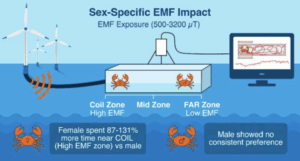Many of us have our cell phones glued to our hands throughout the day. In fact, recent surveys show Americans spend over 3 hours on average using their cell phones daily. For some, that number is much higher. We’ve come to rely on them for everything from staying connected with friends and family, working on-the-go, and for entertainment like shows and music. With this rise in cell phone use, have you ever stopped to wonder what all this wireless exposure could be doing to our health?
Long before smartphones entered the scene and our cell phone use skyrocketed, the U.S. Food and Drug Administration (FDA) nominated “Radio Frequency Radiation Emissions of Wireless Communication Devices” to the National Toxicology Program (NTP) for study to determine health effects on humans. They wanted to understand the potential risks tied to long-term exposure to radio frequency (RF) electromagnetic field radiation (EMF). The results of these studies might surprise you.
The NTP Studies: What Were They Looking For?
As part of the U.S. Department of Health and Human Services, the National Toxicology Program (NTP) “plays a critical role in generating, interpreting, and sharing toxicological information about potentially hazardous substances in our environment.” A two-year toxicology study they conducted on mice and rats was designed to figure out if exposure to RF-EMFs – specifically the kind used in 2G and 3G phones – could cause health issues such as cancer.
These studies were published in November 2018. The frequencies they studied during this time ranged from about 700 to 2700 megahertz (MHz), which was right in the range of most older cell phones. For comparison, some newer 5G phones emit radiofrequency EMFs up to 8 gigahertz (GHz), which is 80,000 MHz.
What the Studies Found
In order to rate the strength of their findings, the NTP uses the following scale:
- Clear evidence: Positive result, with the substance in question showing the ability to cause cancer in laboratory animals
- Some evidence: Positive result, with the substance showing the ability to cause cancer but the strength of the response is less than with “clear evidence.”
- Equivocal evidence: Uncertain findings, meaning the substance may or may not have the ability to cause cancer.
- No evidence: No link found between the substance and cancer.
Here’s where the study gets interesting. The NTP studies found that high exposure to radiofrequency radiation (900MHz) used by cell phones had the following results:
- Clear evidence of malignant tumors in the hearts of male rats. Specifically schwannomas, which are cancerous growths in the heart’s nerve tissue.
- Some evidence of brain tumors in male rats, supporting a growing body of research showing that EMFs could be involved in the silent rise of brain tumors in humans as well.
Some evidence of tumors in the adrenal gland of male rats. These tumors, called pheochromocytomas, can be both benign and malignant.
Follow-Up on DNA Damage
After the initial findings, the NTP published a follow-up article looking at cells that were removed at an earlier point during the ongoing 2-year toxicology study to specifically focus on DNA damage. If not repaired, DNA damage can potentially lead to cancer down the road. Here’s what the follow-up study found:
- Significant DNA damage in the frontal cortex of male mice
- DNA damage in the blood cells of female mice
- DNA damage in the hippocampus – a brain region linked to memory and learning – of male rats.
These findings are worth evaluating further, because if damaged cells can’t properly repair themselves, they can lead to tumor formation later in life. That means the health risks from RF EMFs might not be immediate, but could potentially be serious.

What’s Next? A Need for Future Research
After these findings, the National Institute of Environmental Health Sciences (NIEHS) wanted to dig deeper into the potential health effects of wireless radiation. The goal of their research was to determine the impact of RF-EMF exposure on behavior and stress, conduct real-time monitoring of the body’s response including heart rate, investigate if RF-EMF exposure causes tissue heating, and further study whether it can cause DNA damage.
To study this, they designed a new small-scale exposure system to mimic the conditions of the original studies. The problem? The system they used for this research was designed for 2G and 3G frequencies. Since then, most cell phones operate on 4G and 5G connections. So while the original studies suggested that RF-EMF exposure can have biological effects, there’s still so much we don’t know about our newer wireless technologies that rely on 4G and 5G.
What This Means for Us
The takeaway? There’s a need for more research to fully understand the impact of our modern wireless technology, but there is enough evidence to suggest that cell phone radiation could pose health risks. While we wait for research to catch up with our technology, there are steps we can take to minimize our own EMF exposure.
Reducing EMF Exposure
- Use speakerphone or wired headphones instead of holding your phone directly to your ear.
- Keep your phone and other wireless devices away from your body. Remember, intensity increases with proximity, so a little distance can go a long way to reducing your EMF exposure.
- Turn off Wi-Fi and Bluetooth when you’re not using them.
- Consider placing EMF protection such as Aires’ Lifetune devices around the home, or use a wearable device to reduce the impact of EMF on your body on-the-go.
- Use airplane mode when possible to cut all signals, especially when your signal is weak. The phone works harder to connect in low-service areas, increasing exposure.

Moving Forward with Knowledge
The NTP studies gave us valuable information and made one thing clear: our phone usage carries potential risks. However, this isn’t a reason to go off-grid and throw our cell phones out the window. Rather, it’s a reminder to be mindful of our tech usage and our habits surrounding cell phones.
Taking simple steps to limit our exposure is key, especially since the effect of 4G and 5G technologies are still largely unknown. Keep up-to-date on the research and encourage loved ones to use safer cell phone habits. Until research and safety guidelines catch up, protecting ourselves and our families from potential EMF risks falls on us. Stay informed, stay empowered! Learn more about device usage and screen time effects on children and teens here.
Read More Posts Below
- What Crabs and Power Cables Can Teach Us About EMF
- Proactive Pregnancy: Adding EMF Protection to Your Birth Plan & Health Stack
- EMF in EVs: What the Latest Research Says About EMF Exposure in Cars
- EMF Isn’t All Bad: The Healing Side of Electromagnetic Fields (And Why Protecting Our Kids Still Matters)
- 30+ Years of Research on EMF Exposure | Why It’s Time to Take Control







